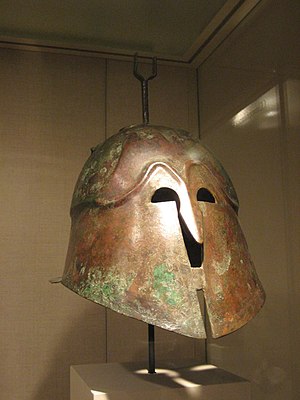Apulian-Corinthian helmet
| Apulian-Corinthian helmet | |
|---|---|

|
|
| Information | |
| Weapon type: | Protective weapon |
| Designations: | Apulian-Corinthian helmet |
| Use: | helmet |
| Working time: | about 500 BC Until about 100 AD |
| Region of origin / author: |
Greece , Italy , armory |
| Distribution: | Italy, Greece |
| Lists on the subject | |
An Apulian-Corinthian helmet , also known as a "pseudo-Corinthian helmet", is a protective weapon from Italy.
description
An Apulian-Corinthian helmet is usually made of bronze . It is made in a striking shape that hardly resembles the traditional Greek helmets in any way. The helmet bell is made in the shape of a bowl, the cheek flaps are not made separately, but integrated into the helmet bell. A dividing line runs in the upper third of the helmet, which imitates a two-part production, although the helmet was driven from one piece . The eye slits are relatively small, the eyebrows are clearly prominent and stylized in high relief. The nose protection is shaped outwardly in the manner customary for this type. A wide neck protection is worked out on the neck. Engravings depicting human and animal figures are often made on the entire helmet bowl. On the top of the helmet there are often brackets in different shapes, mostly fork-shaped (so-called bush fork), in order to attach the helmet ornament ( Zimier ). On some versions of the helmet, additional holders for a helmet bush are attached to the right and left of the helmet ornament. The helmets are about 30 cm high, about 30 cm long and weigh about 1500 g.
Individual evidence
- ^ Website Hermann Historica, available online, (German., Accessed on February 12, 2011) ( Memento from August 3, 2012 in the web archive archive.today )
literature
- Hermann Pflug : Antique helmets (= art and antiquity on the Rhine. No. 129). Rheinland-Verlag, Cologne 1989, ISBN 3-7927-1112-5 , p. 20.
- Hermann Born, Svend Hansen : Early Greek bronze helmets (= Axel Guttmann Collection 3). Verlag Sammlung Guttmann bei von Zabern, Mainz 1994, ISBN 3-8053-1665-8 , p. 78.
- Fritzi Jurgeit: The Etruscan and Italian bronzes as well as objects made of iron, lead and leather in the Badisches Landesmuseum Karlsruhe (= Terra Italia 5). With a contribution by Josef Riederer . Istituti Editoriale e Poligrafici Internazionali, Pisa et al. 1999, ISBN 88-8147-177-9 .